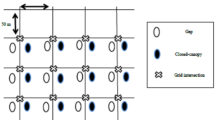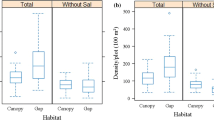Abstract
The bamboo Chusquea quila (Poaceae:Bambuseae) is the most abundant understory species ofNothofagus-dominated forests at low elevations inthe Chilean Lake District. Species of this genus strongly inhibit theestablishment and growth of tree species, especially those of the genusNothofagus. At intervals of many years, this bambooflowerssynchronously and dies, creating large-scale disturbances. The mainobjective of this study was to determine the influence of bamboo dieback ontreeregeneration, especially of shade-intolerant species. The forest studiedis a remnant stand of old-growth forest dominated by emergent individualsof N. obliqua and Eucryphiacordifoliawhich project about 10 m above a main canopy formed byAextoxicon punctatum, Laureliaphilippiana, and Podocarpus saligna. Treeseedlings that established prior to bamboo dieback were recorded in six gapsdensely covered by bamboo. After the dieback event in the early 1990's,recruitment, height growth and survivorship were monitored in four gaps duringtwo growing seasons. After the synchronous mass flowering and death ofChusqueaquila, both reorganization of advance regeneration and new seedlingrecruitment were observed in gaps. The advance regeneration consisted mainly ofthe shade-tolerant species A. punctatum,L. philippiana, and Amomyrtus luma.These species together with E. cordifolia accounted forover 90% of the total individuals in gaps. During the following twoseasons, c. 40% of the advance regeneration either died or was damaged.Root suckers of E. cordifolia and L.philippiana were taller and grew faster than the seedlings of otherspecies. Nothofagus obliqua was unable to establishadvanceregeneration in gaps formerly dominated by bamboo. New recruitment resulted inthe synchronized establishment of treeseedlings, especially less shade-tolerant species such as N.obliqua, Aristotelia chilensis,Rhaphithamnus spinosus, and E.cordifolia. These species recruited into the gaps almost entirelyduring the first season right after the bamboo dieback. However, by the end ofthe second season, these species had a lower density due to a combination oflower recruitment rate, shortened recruitment period, and greater mortalityratecompared to the shade-tolerant species. New bamboo seedlings grew fasterand were more abundant than tree seedlings, except for root suckers (bothnew establishment and advance regeneration) of E.cordifolia which is more likely to successfully recruit into thecanopy. Seedlings of N. obliqua compete poorly with bambooseedlings; its successful recruitment may require bamboo flowering coincidentwith a mast seed year for the tree species.
Similar content being viewed by others
References
Armesto J.J. and Figueroa J. 1987. Stand structure and dynamics in the temperate rain forests of Chiloé Archipelago, Chile. Journal of Biogeography 14: 367–376.
Armesto J.J. and Fuentes E.R. 1988. Tree species regeneration in a mid-elevation, temperate rain forest in Isla de Chiloé, Chile. Vegetatio 74: 151–159.
Becker J. 1981. Estudio de producción de litter en bosques latifoliados del sur de Chile. Facultad de Ciencias Forestales, Universidad Austral de Chile, Valdivia.
Campbell J.J.N. 1985. Bamboo flowering patterns: a global view with special reference to east Asia. Journal of the American Bamboo Society 6: 17–35.
Canham C.D. and Marks P.L. 1985. The response of woody plants to disturbance: patterns of establishment and growth. In: Pickett S.T.A. and White P.S. (eds), The Ecology of Natural Disturbance and Patch Dynamics. Academic Press, New York, pp. 197–216.
CONAF 1993. Antecedentes técnicos y diagnóstico general de incendios forestales en la décima región derivado del fenómeno de la quila seca. Puerto Montt, Corporación Nacional Forestal, Programa Manejo del Fuego.
di Castri F. 1968. Esquisse écologique du Chili. In: Deboutteville C. and Rapoport E.H. (eds), Biologue de l'Amerique Australe. Volume IV, Paris, pp. 7–52.
Donoso C. 1989. Antecedentes básicos para la silvicultura del tipo forestal siempreverde. Bosque (Chile) 10: 37–53.
Donoso C., Grez R., Escobar B. and Real P. 1984. Estructura y dinámica de bosques del tipo forestal siempreverde en un sector de Chiloé Insular. Bosque (Chile) 5: 82–104.
Donoso C., Escobar B. and Urrutia J. 1985. Estructura y estrategias regenerativas de un bosque virgen de Ulmo (Eucryphia cordifolia Cav.), Tepa (Laurelia philippiana Phil.) Looser en Chiloé, Chile. Revista Chilena de Historia Natural 58: 171–186.
Donoso C. 1993. Bosques templados de Chile y Argentina. Variación, Estructura y Dinámica Editorial Universitaria, Santiago de Chile.
Ehrenfeld J.G. 1980. Understory response to canopy gaps of varying size in a mature oak forest. Bulletin of the Torrey Botanical Club 107: 29–41.
González M.E. and Donoso C. 1999. Producción de semillas y hojarasca en Chusquea quila (Poaceae: Bambusoideae), posterior a sufloración sincrónica en la zona centro-sur de Chile. Revista Chilena de Historia Natural 72: 169–180.
González Y. 1998. Memoria histórica y saber cotidiano: validación del conocimiento en el florecimiento de la Chusquea quila en el sur de Chile (X región). Facultad de Educación y Humanidades, Universidad de la Frontera, Temuco.
Grau R. and Rivera-Ospina D. 1996. Regeneración temprana de Chusquea tomentosa (Bambusoideae-Poaceae) en Talamanca, Costa Rica. Revista de Biología Tropical 44: 691–692.
Huber A. 1970. Diez años de observaciones climatológicas en la estación Teja-Valdivia, Chile 1960-1969. Universidad Austral de Chile, Valdivia.
Huenneke L.F. 1983. Understory response to gaps caused by the death of Ulmus americana in central New York. Bulletin of the Torrey Botanical Club 110: 170–175.
Janzen D.A. 1976. Why bamboos wait so long to flower. Annual Review of Ecology Systematics 7: 347–391.
Kappele M. 1992. Structural and floristic differences between wet Atlantic and moist Pacific montane Myrsine-Quercus forests in Costa Rica. In: Balslev H. and Luteyn J.L. (eds), Páramo: An Andean Ecosystem under Human Influence. Academic Press, London, pp. 61–70.
Kudoh H. and Ujiie M. 1990. Regeneration of Sasa kurilensis and tree invasion after mass flowering. Bamboo Journal 8: 38–49.
Makita A., Makita H. and Nishiwaki A. 1995. Mass flowering of Sasa kurilensis to the south of Lake Towada, northern Japan, in 1995. Bamboo Journal 13: 34–41.
Makita A. 1997. The regeneration process in the monocarpic bamboo, Sasa species. In: Chapman G.P. (ed.), The Bamboos. Academic Press, London, pp. 135–145.
Marks P.L. 1974. The role of pin cherry (Prunus pensylvanica L.) in the maintenance of stability in northern hardwood ecosystems. Ecological Monograph 44: 73–88.
Marticorena C. and Quezada M. 1985. Catálogo de la Flora Vascular de Chile. Gayana 42: 1–157.
Monroy M. and Soto J. 1976. Regeneración natural de Chusquea quila. Universidad Austral de Chile, Valdivia (unpublished).
Müller-Using B. and Schlegel F. 1981. The development of seedlings of Chilean Nothofagus species in a shaded area. Plant Research and Development 13: 152–184.
MurÚa R. and González L.A. 1985. Producción de semillas de especies arbóreas en la pluviselva valdiviana. Bosque (Chile) 6: 15–23.
MurÚa R., González L.A., González M.E. and Jofre C. 1996. Efectos del florecimiento del arbusto Chusquea quila Kunth (Poaceae) sobre la demografía de poblaciones de roedores de los bosques templados fríos del sur chileno. Boletín de la Sociedad de Biología de Concepción 67: 37–42.
Nakashizuka T. and Numata M. 1982. Regeneration process of climax beech forests. I. Structure of a beech forest with the undergrowth of Sasa. Japanese Journal of Ecology 32: 57–67.
Nakashizuka T. 1988. Regeneration of Beech (Fagus crenata) after the simultaneous death of undergrowing dwarf bamboo (Sasa kurilensis). Ecological Research 3: 21–35.
Oliver C. 1981. Forest development in North America following major disturbances. Forest Ecology and Management 3: 153–168.
Peters R., Nakashizuka T. and Ohkubo T. 1992. Regeneration and development in beech-dwarf bamboo forest in Japan. Forest Ecology and Management 55: 35–50.
Pisano E. 1950. Observaciones sobre la renovación del bosque de Laurel y Ulmo en la región del Lago Llanquihue. Apartado de Agricultura Técnica 10: 27–49.
Quintanilla V. 1974. La carta bioclimática de Chile Central. Revista Geográfica de Valparaíso (Chile) 5: 33–55.
Read J. and Hill R.S. 1985. Photosynthetic responses to light of Australian and Chilean species of Nothofagus and their relevance to the rainforest dynamics. New Phytologist 101: 731–742.
Rosas C.P. 1991. Estudio de la vegetación leñosa en áreas afectadas por deslizamientos en el Parque Nacional Puyehue, Osorno (X Región). Facultad de Ciencias Forestales, Universidad Austral de Chile, Valdivia.
Runkle J.R. 1982. Pattern of disturbances in some old-growth mesic forests of eastern North America. Ecology 63: 1533–1546.
Runkle J.R. 1985. Disturbances regimes in temperate forests. In: Pickett S.T.A. and White P.S. (eds), The Ecology of Natural Disturbance and Patch Dynamics. Academic Press, New York, pp. 17–33.
SAS/STAT® 1989. User's guide, Version 6, Cary. 4th edn. Vol. 1. NC: SAS Institute Inc.
Stern M.J. 1995. Vegetation recovery on earthquake-triggered landslide sites in the Ecuadorian Andes. In: Churchill S.P., Balslev H., Forero E. and Luteyn J.L. (eds), Biodiversity and Conservation of Neotropical Montane Forests. The New York Botanical Garden, pp. 207–220.
Tanaka N. 1988. Tree invasion into patchy dwarf-bamboo thickets within a climax beech-fir forest in Japan. In: During H.J., Werger M.J.A. and Willems J.H. (eds), Diversity and Pattern in Plant Communities. SPB Academic Publishing, pp. 253–261.
Taylor A.H. and Qin Zisheng 1988. Regeneration patterns in old-growth Abies-Betula forests in the Wolong Natural Reserve, Sichuan, China. Journal of Ecology 76: 1204–1218.
Taylor A.H., Qin Zisheng and Jie Liu 1995. Tree regeneration in an Abies faxoniana forest after bamboo dieback, Wang Lang Natural Reserve, China. Canadian Journal Forest Research 25: 2034–2039.
Taylor A.H. and Qin Zisheng 1997. The dynamics of temperate bamboo forests and panda conservation in China. In: Chapman G.P. (ed.), The Bamboos. Academic Press, London, pp. 189–203.
Veblen T.T., Ashton D.H. and Schlegel F.M. 1979. Tree regeneration strategies in a lowland Nothofagus-dominated forest in south-central Chile. Journal of Biogeography 6: 329–340.
Veblen T.T. 1982. Growth patterns of Chusquea bamboos in the understory of Chilean Nothofagus forests and their influences in forest dynamics. Bulletin of the Torrey Botanical Club 109: 474–487.
Veblen T.T., Schlegel F.M. and Oltremari J.V. 1983. Temperate broad-leaved evergreen forests of South America. In: Ovington J.D. (ed.), Temperate broad-leaved evergreen forests. Ecosystems of the World 10 Elsevier, pp. 5–31.
Veblen T.T. 1985. Forest Development in Tree-fall Gaps in the Temperate Rain Forests of Chile. National Geographic Research 1: 162–183.
Veblen T.T. 1992. Regeneration dynamics. In: Glenn-Lewin D., Peet R. and Veblen T.T. (eds), Plant Succession: Theory and Prediction. Chapman and Hall, London, pp. 152–187.
Veblen T.T., Donoso C., Kitzberger T. and Rebertus A.J. 1996. Ecology of southern Chilean and Argentinean Nothofagus forests. In: Veblen T.T., Hill R. and Read J. (eds), The Ecology and Biogeography of Nothofagus Forests. Yale University Press, New Haven, Connecticut, pp. 293–353.
Widmer Y. 1997. Life history of some Chusquea species in old-growth oak forest in Costa Rica. In: Chapman G.P. (ed.), The Bamboos. Academic Press, London, pp. 17–31.
Zar J.H. 1996. Biostatistical Analysis. 3rd edn. Prentice Hall, New Jersey.
Author information
Authors and Affiliations
Rights and permissions
About this article
Cite this article
González, M.E., Veblen, T.T., Donoso, C. et al. Tree regeneration responses in a lowland Nothofagus-dominated forest after bamboo dieback in South-Central Chile. Plant Ecology 161, 59–73 (2002). https://doi.org/10.1023/A:1020378822847
Issue Date:
DOI: https://doi.org/10.1023/A:1020378822847




